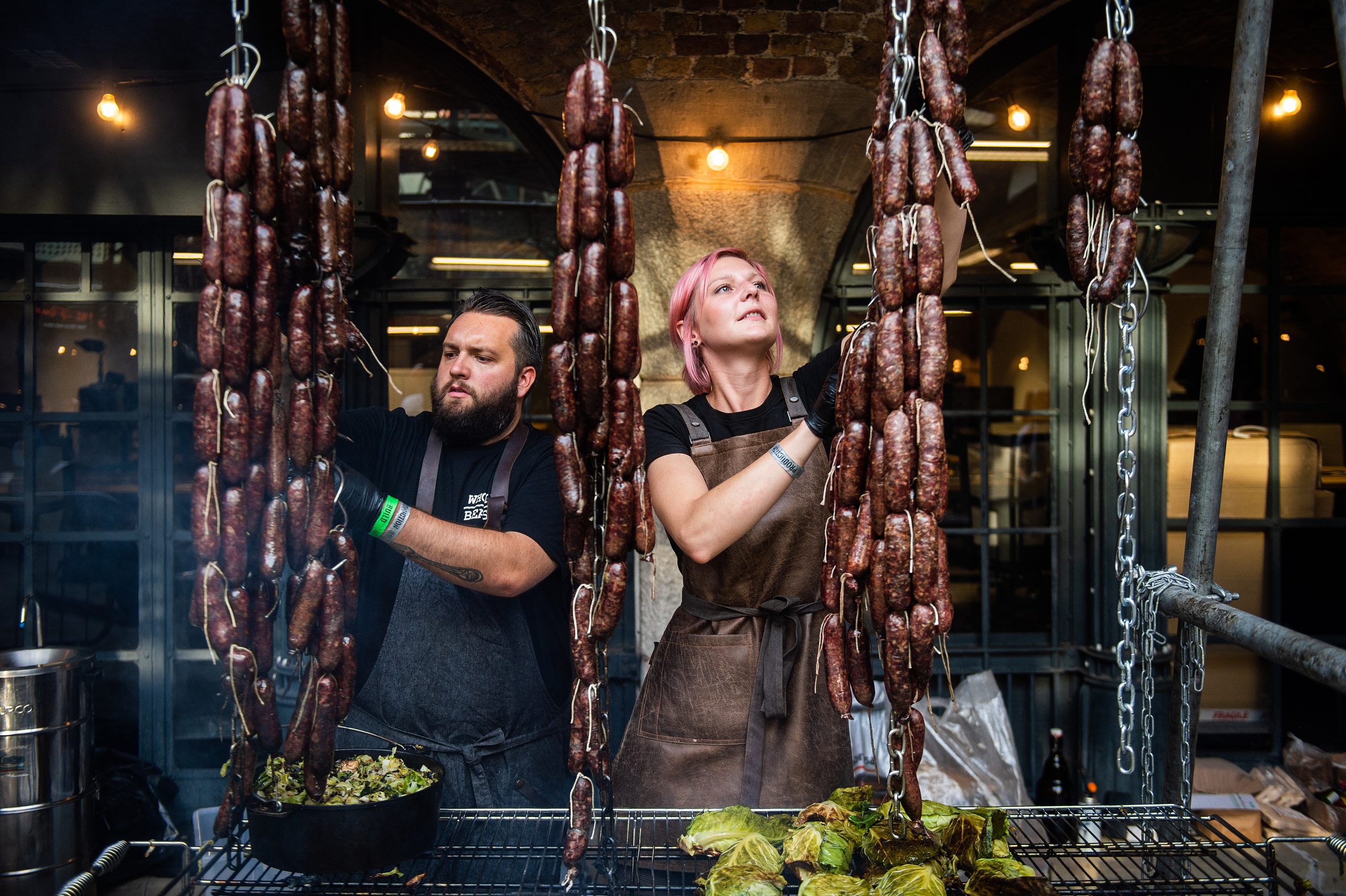
Recipe: Silo, Brighton
This is a punchy dish with big, spicy attitude. The intense flavour comes from the two-week fermented beetroot, which works in harmony with the beef. This completely raw dish looks beautiful too, and will not fail to impress. If you have the time, you should definitely make the brown butter to dress the beef. This dish is a great example of maximising resources – using secondary meat cuts such as small cuts (and even trim) that would often get thrown away or used for a lesser purpose. You can also have a ‘leapfrog’ production process with the beetroot: the first time you make this recipe, you can use your fresh beetroot for anything you like, then ferment the excess. Next time, you’ll have a batch of fermented beetroot and be ready to make the next. This way of absorbing waste into fermentation is a beautiful part of a zero-waste philosophy. DM

RAW BEEF, FERMENTED BEETROOT COLESLAW AND WILD GARLIC
Serves 4–6
Ingredients
Approx 10–15 large candy beetroots
(you need enough to produce lots of fresh beetroot discs, fresh coleslaw, plus fermented beetroot – enough to fill a Kilner jar
or fermentation crock)
Sea salt
250g block of butter
(way more than you need but brown butter is an amazingly versatile product that will sit happily in your fridge for ages –
use with fish dishes, meat dishes and even on desserts)
200g wild garlic
100g parsley sprigs
800ml rapeseed oil
3 eggs
Juice of half a lemon
300g beef muscle, from a happy, grass-fed cow
Coarse sea salt and freshly ground black pepper
10g salted wild garlic
capers (optional)
Method
If you are ‘leapfrogging’ (ie you already have some fermented beetroot ready), simply prepare your fresh beetroot. Peel the skins off the beetroot and add them to your compost heap. Use a mandolin to slice the beetroot into 1mm (1/16 inch) sheets. Cut 2cm (. inch) discs out of the sheets with a cutter or apple corer, set the trim aside – this will make either your first or next batch of fermented beetroot. You also need to coarsely grate fresh beetroot (around 2 tablespoons) for the coleslaw and set it aside for the final dish.
To make the fermented beetroot, weigh the trimmed beetroot (that’s what’s left after all the fresh discs and grated beetroot have been set aside), then add 2% of its weight in sea salt to the mix.
In a large bowl, massage the salt into the beetroot before squashing it all into a sterilised Kilner jar or fermentation crock. Ideally, you want to fill the jar to the very brim, squashing it down firmly until the ‘leached’ moisture covers all the solids right to the top. Leave to ferment for between 10 days and 2 weeks.
There will be plenty of excess ferment, which is brilliant eaten on its own as a snack. I always ferment at least ten times as much as I actually need.
To make the brown butter, put the butter into a small pan with a solid base on a low-medium heat. Cook it slowly, until it smells nutty and the sound of crackling stops. Immediately pass it through a fine sieve and reserve. When it cools down, it should be a deep brown colour, smelling nutty and sweet. This can be used to dress anything!
To make a wild garlic oil, blanch the wild garlic and parsley in boiling water for 30 seconds, then plunge into ice water. Drain the herbs extremely well, then put in the blender with half the oil and turn the blender on. After some time, the friction of the blender creates heat, so keep the wild garlic oil blending until the oil reaches 64°C (147°F), then pass through a very fine sieve or cloth.
There will be plenty of excess wild garlic oil, which can be used for a diverse array of dishes from pasta to salads.
Next, make a quick mayonnaise. Crack the eggs into a deep narrow container and hand-blend them with the lemon juice. Then, pour the remaining oil slowly into the egg mixture, blending as you go, so that it emulsifies into a thick mayonnaise. Don’t worry about the seasoning, as you will have to season the final coleslaw.
To finish the coleslaw, combine 2 tablespoons of the fermented beetroot with an equal amount of fresh grated beetroot and 1 tablespoon of the mayonnaise. Season to taste.
When you are ready to serve, dice the beef into large chunks. Season the tartare with a touch of the wild garlic oil, a good drizzle of brown butter, a sprinkle of coarse sea salt and a heavy grind of black pepper.
To serve, spoon a tablespoon of the coleslaw on to each plate. Spoon a tablespoon of the tartare on top of the coleslaw. Finally, scatter the discs of fresh beetroot randomly across thedish, and dress with a generous amount of wild garlic oil, a pinch of salt and the wild garlic capers (if using).
Words by Douglas McMaster
Image Credits by Mariana Mevdevara



